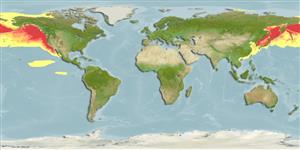Common names from other countries
Environment: milieu / climate zone / depth range / distribution range
Écologie
Bathydémersal. Subtropical; 90°N - 0°S, 180°W - 180°E
Distribution
Pays | Zones FAO | Écosystèmes | Occurrences | Introductions
Pacific Ocean and the Arctic.
Length at first maturity / Taille / Poids / Âge
Maturity: Lm ? range ? - ? cm Max length : 210 cm TL mâle / non sexé; (Ref. 1394); 150 cm TL (female); poids max. publié: 270.0 kg (Ref. 1394); poids max. publié: 270.0 kg
Feeds on many varieties of epipelagic and vertically migrating schooling and non-schooling fish and squid; feeding is at night (Ref. 1394). Feeds on many varieties of epipelagic and vertically migrating schooling and non-schooling fish and squid; feeding is at night (Ref. 1394).
Life cycle and mating behavior
Maturité | Reproduction | Frai | Œufs | Fécondité | Larves
Estrus and copulation occur about a week after parturition. Implantation is expected 120 days after copulation.
Jefferson, T.A., S. Leatherwood and M.A. Webber. 1993. (Ref. 1394)
Statut dans la liste rouge de l'IUCN (Ref. 130435)
statut CITES (Ref. 108899)
Not Evaluated
Not Evaluated
Utilisations par l'homme
Pêcheries: commercial
FAO - pêcheries: landings, species profile | FishSource | Sea Around Us
Outils
Sources Internet
Estimates based on models
Preferred temperature
(Ref.
115969): 0.2 - 3.8, mean 1.6 (based on 2446 cells).
Résilience
Milieu, temps minimum de doublement de population : 1,4 à 4,4 années (K=0.03-0.38).
Vulnérabilité
Moderate to high vulnerability (51 of 100).
Catégorie de prix
Unknown.
